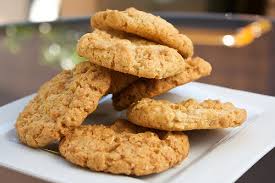My Anzac Biscuits
This is my Anzac Biscuit Blog post and you will see how to make Anzac Biscuits, the history behind anzac day and a really good recipe. I hope you like my post.
In World War 1 and 2 they ate food like canned food, jam, stew and also very dry biscuits. The mothers, wives and girlfriends were very concerned about the nutritional value supplied to there men. The food had to be able to be in a boat with out any refrigerating facilities for 2 months so, a lady came up with the answer. She used a basis Scottish recipe that was made out of rolled oats and was able to be eaten in the period of time while it was in the ship. The biscuit was named ANZAC BISCUITS after the landing on Gallipoli.
Anzac Biscuit Recipe: Interesting Facts About Anzac
100g Butter Anzac Soldiers were all volunteers
3 tbsp Golden Syrup
1/4 cup Boiling Water 11,000 people were killed and 23,500 were wounded
1 1/2 tsp Baking soda
100g Flour There is no town called Gallipoli, it is the name of the area
150 Sugar
100g Rolled Oats
75g Desiccated Coconut
1 1/2 tsp Baking soda
100g Flour There is no town called Gallipoli, it is the name of the area
150 Sugar
100g Rolled Oats
75g Desiccated Coconut
Method

 Preheat the oven to 180ºC. Gently heat the butter and golden syrup in a small saucepan until the butter melts. Pour the boiling water into a cup and dissolve the soda. Mix the flour, sugar, rolled oats and coconut together in a large bowl. Add the soda and water to the saucepan of hot butter and syrup and immediately pour the foaming mixture into the dry ingredients. Mix thoroughly. Cover two baking trays with baking paper, or wipe with butter and dust with flour. Place heaped teaspoonfuls of the mixture on the prepared trays, leaving room for spreading. Bake at 180ºC for 15-20 minutes until the biscuits have melted flat and baked to a rich brown. Remove from the oven and leave the biscuits to harden for a few minutes before lifting with a spatula. Place in a single layer on a rack to finish cooling. The recipe makes around 36
Preheat the oven to 180ºC. Gently heat the butter and golden syrup in a small saucepan until the butter melts. Pour the boiling water into a cup and dissolve the soda. Mix the flour, sugar, rolled oats and coconut together in a large bowl. Add the soda and water to the saucepan of hot butter and syrup and immediately pour the foaming mixture into the dry ingredients. Mix thoroughly. Cover two baking trays with baking paper, or wipe with butter and dust with flour. Place heaped teaspoonfuls of the mixture on the prepared trays, leaving room for spreading. Bake at 180ºC for 15-20 minutes until the biscuits have melted flat and baked to a rich brown. Remove from the oven and leave the biscuits to harden for a few minutes before lifting with a spatula. Place in a single layer on a rack to finish cooling. The recipe makes around 36